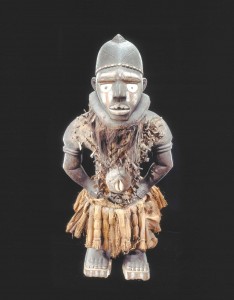NOMA connects our Congo to the Kongo in new exhibit
9th March 2015 · 0 Comments
By Charmaine Jackson
Contributing Writer
Traces of African roots are ingrained in New Orleans culture. Pieces of traditions, music, rituals, cuisine, and art among other cultural mediums were influenced by a kingdom across the waters called Kongo.
Kongo across the Waters, New Orleans Museum of Art’s newest exhibition, specifically explores the connection between the history of the African Kongo kingdom and its influences on African American culture in the southeast region of the United States.

Yombe peoples, Mayombe, Lower Congo, DRC, Anthropomorphic power figure, nkisi nkondi,19th century, collection RMCA Tervuren, EO.0.0.7777.
The exhibit includes more than 160 works of historic art and artifacts. Since the Royal Museum for Central Africa is currently closed for renovations, it loaned several never before exhibited archaeological discoveries and items that date back to when the Kongo first emerged as a major Atlantic presence, to the present day, according to the Kongo across the Waters web site. “This is a rare opportunity for us to show these masterpieces,” said Bill Fagley, Françoise Billion Richardson Curator of African Art of NOMA. “If our museum had an unlimited budget, we would not be able to acquire these pieces because they have all been spoken for and are in collections,” he continued.
Divided into five sections, the first object on display is of a 16th-century ivory trumpet, which was traditionally sounded to welcome guests. In the case of Kongo, it also represents Portuguese induction into their Kongolese territory. Kongo, which is different from the term “Congo” commonly used today, refers to an old African kingdom that is now located north of Angola. An account of Kongo civilization before and after colonization is highlighted and includes how the Kongolese fused both cultures, is discovered in the first section. For example, the introduction of Christianity prompted them to carve crucifixes out of wood and metals, to symbolize their newly adopted faith. The next section features rare archaeological items, such as ceramics and domestic wares that were intentionally buried in slave cabins and European colonial mansions that informed of rituals and practices. Trade developments and its influence on Kongo art were showcased in the third section, along with the introduction to Kongo power figures called minkisi.
The fourth section delves into Kongo and how it resonates with African-American cultures, including in New Orleans. For New Orleanians, this portion of the exhibit may answer questions concerning the observance and participation in certain rituals, as well as uncover their origins. A video presentation explaining the connections of Congo Square to Kongo culture consists of interviews with Luther Gray and Freddi Williams Evans of New Orleans. Gray, founder of Bamboula 2000, demonstrates the relationship between Kongo drumming and beats locals and visitors hear in Congo Square, today. Evans, author of Congo Square African Roots in New Orleans, discusses how dance is influenced by Kongo culture. One of many mentioned cultural influences through dance include choreography commonly performed during historically African-American fraternity and sorority step shows. The last section displays Kongo-inspired art by contemporary artists, such as Radcliffe Bailey, Edouard Duval-Carrié, Renee Stout, José Bedia and Steve Bandoma.
Since New Orleans is a predominately African-American city, Fagley said he was inspired to build the African art collection so that the community could learn about their history and heritage. “What better way to do it than through art because their belief systems are very well demonstrated in the art objects?”
He continued, “I really would love for the African-American New Orleanians to come learn about their heritage. I think they’ll be richly rewarded and excited about what they will find because Africans were and still are a very sophisticated people with elegance and style, and I just want the people of New Orleans to appreciate that.
The exhibit was organized by The Harn Museum of Art at the University of Florida and the Royal Museum for Central Africa in Tervuren, Belgium.
This article originally published in the March 9, 2015 print edition of The Louisiana Weekly newspaper.



